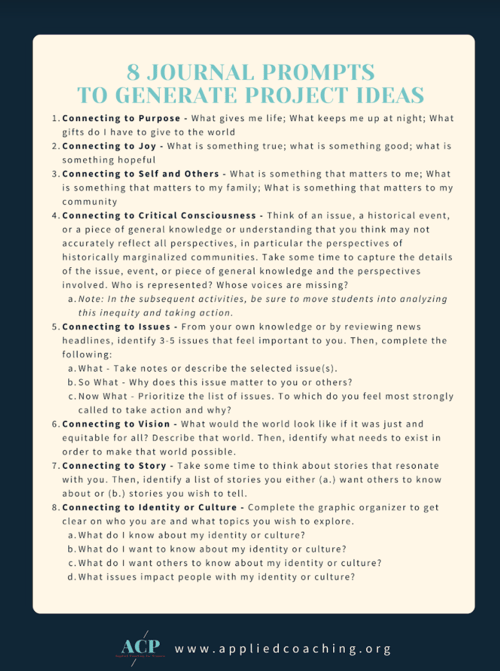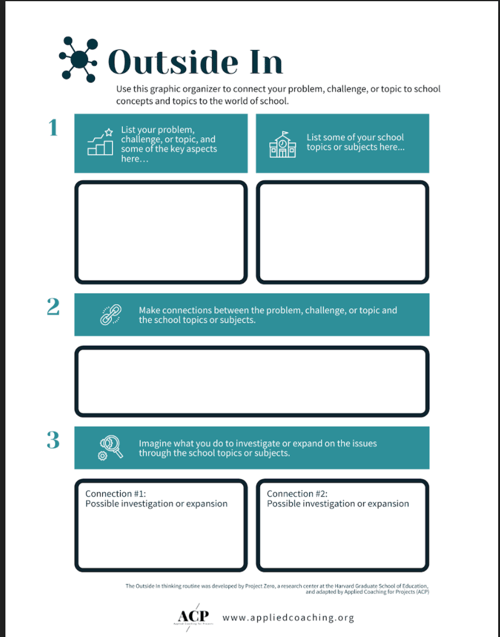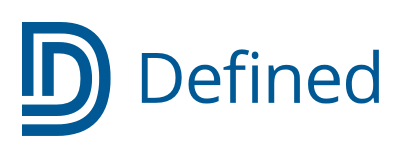Educators Blog
How to Help Students Select Meaningful Projects
By Dr. Gina Olabuenaga,
Every child is an artist. The problem is how to remain an artist once [they] grow up.”
- Pablo Picasso
Each child is gifted. Each child is an artist. Period. How do we help them understand their gifts, listen to their inner artist so that they may know and move in the world?
In this blog, I would like to shed light on how to support student “artistry”, as Picasso calls it, through student-led projects. Now, I know this may sound a bit daunting. So, let’s start small. Here, we begin with how to put students in the driver’s seat for meaningful project selection.
High-Quality Project-Based Learning (HBPBL) is a learner-centered framework that articulates the elements of the student experience during a project. Learn more about the framework here. This blog is organized around 3 of the 6 elements: Authenticity, Intellectual Challenge and Accomplishment, and Collaboration. There will be overlap amongst these three and for the sake of the blog, we will keep the sections relatively distinct for now.
Our job is not to prepare students for something. Our job is to help our students prepare for anything.”
-A.J. Juliani
It comes up a lot that education, as it is currently designed and implemented, prepares students for a world that doesn’t exist. It is a system still based on skills that are no longer needed. The global pandemic has only deepened this critique and brought to the masses the realities many communities, primarily Indigenous peoples and communities of color, have been experiencing for generations.
*Note: If you have 23 minutes, I highly recommend checking out this powerful TED Talk by Sugata Mitra called A School in the Clouds. Mitra talks about the origins of the educational system and who and what it was intended to serve.
As such, the role of education can, and should, shift to focusing on preparing students for life. Identifying topics they care about is one place to start. While this certainly connects to, Intellectual Challenge and Accomplishment, we begin our discussion with Authenticity.
Authenticity
To get you up to speed, Authenticity, under the HQPBL Framework, is defined as “Students work[ing] on projects that are meaningful and relevant to their culture, their lives, and their future.” (HQPBL, p. 3)
So, how do we get students to dig deeply into the issues that matter to them? Here are some exercises that help get them started:
Video or Written Journal
Use prompts such as the ones below to get them off the ground. Note, if prompts are presented as a set, we recommend they are offered as a set.
 Click HERE to download these prompts
Click HERE to download these prompts
Visible Thinking Routine - Name, Describe, Act
In this routine by Project Zero, learners select an image, event, or topic to examine closely. In this context of learners identifying authentic topics, this routine aims to bring the topic to life in a visceral and concrete way. Then, they can move into making meaning of the issue and selecting a project focus. This is discussed in the next section of the blog.
Here are the prompts for Name, Describe, Act:
NAME: Recalling from memory, name and make a list of all of the parts or features you can remember. These will most likely be nouns, things you can point to, and name.
DESCRIBE: For each of the things you have named, add a description. What adjectives would you add to the nouns you have listed?
ACT: For each of the things you have named, tell how they act. What are they doing? What is their function? How do they contribute to the whole?
We wish to offer another simple gem to support learners in identifying issues that matter to them. Circles of Action offers students an opportunity to name ways to contribute at different levels. In a video or written journal, learners consider the following:
What can I do to contribute…
-
-
In my inner circle (of friends, family, the people I know)?
-
In my community (my school, my neighborhood)?
-
In the world (beyond my immediate environment)?
-
There is another simple gem we wish to offer to support learners in identifying issues that matter to them. Circles of Action offers students an opportunity to name ways to contribute at different levels. In a video or written journal, learners consider the following:
What can I do to contribute…
- In my inner circle (of friends, family, the people I know)?
- In my community (my school, my neighborhood)?
- n the world (beyond my immediate environment)?
Now that learners have had a chance to identify authentic topics to explore, let’s take a look at how to sharpen the focus through Intellectual Challenge and Accomplishment.
It is literally neurobiologically impossible to think deeply about things you don’t care about”
- Dr. Mary Helen Immordino-Yang
Mind reading is not an official science. As such, we need to have students lead the way on what animates them, what they are curious about. Here are some ways to help and make space for learners to identify the challenges and questions that matter to them.
Intellectual Challenge and Accomplishment
This element of HQPBL is pretty straightforward. It reads: “Students learn deeply, think critically, and strive for excellence.” (HQPBL, p. 3) In order to do this, learners must be clear on the challenge they are exploring so that they can think deeply about it. And, as Dr. Immordino-Yang said, learners can’t think deeply or move to make a difference if they don’t care about it.
Earlier in the blog, we highlighted ways to elevate or surface topics for young people to explore. The next step is to distill the issue down to a central focus. To do so, use these four (4) basic steps*:
- Revisit the problem, challenge, or topic.
- Brainstorm/explore the aspects of the issue.
- Categorize and then prioritize those aspects.
- Select one to make the focus of the project.
Visible Thinking Routine - Outside In
Now, if the problem or topic does not appear to connect directly to school content, try the adapted version of the Visible Thinking Routine – Outside In – below.

Once students have clarified a problem, challenge, or topic, move them into codifying a question. This will become the compass for their learning in the project and create some boundaries as they complete their learning explorations and product development. In this blog, we will focus on how to do this through the HQPBL element of Collaboration.
Beloved community is formed not by the eradication of difference but by its affirmation, by each of us claiming the identities and cultural legacies that shape who we are and how we live in the world”
- bell hooks
Collaboration
If the term “beloved community” is new to you, I encourage you to check out the wise words of bell hooks in this conversation with Georgie Brosi (hooks & Brosi, 2012). “A beloved community defines the relationships among those working for change and also the desired result of these efforts.” (hooks & Brosi, 2012, p. 76) As bell hooks says, we forge this community through the affirmation of who we are. In this section, I will highlight ways for learners to make public their identities and cultural legacies, to get clear on their purpose through collaboration with their peers.
The Tubric with a Carousel
Writing a driving question for a project is a tricky business. Here is a two-part activity that gets students collaborating on their purpose.
- PART 1: THE TUBRIC: The Tubric is a scaffolding tool that includes stems to help students draft driving questions. Begin by having students use the tool to create a question.
- PART 2: CAROUSEL: After students are done generating a list, ask them to pick one they want to workshop with a small group. Each student writes their question on a piece of paper (or on a shared document if participating virtually). They pass (literally or virtually) their question off to the person next to them. Each person reviews the driving question and tries to write it in a new or different way. Then, switch again, passing off to the next person. Do this until the question returns to its owner. Review the list of revised questions and debrief the experience.
The 5 Whys
One of the earliest (and most prolific) questions in a young person’s life is “why.” This protocol helps learners dig deeper into the heart of why the issue matters to them. Below is an adapted version of the protocol from the School Reform Initiative (SRI). Note, this can be done in pairs or in small groups.
- Pre-work - The presenter drafts a driving question for their problem, challenge, or topic.
- Presentation - The presenter shares their driving question along with some context for the question. What is the topic they are exploring? Why does it matter to them?
- Clarifying questions - The audience asks simple yes/no style questions as needed.
- Decision - The audience (or partner) decides on a “why” question to ask the presenter about their driving question.
- “Why” questioning - The audience or partner shares their “why” question. The presenter answers. This process of generating a “why” question and response goes until there have been five (5) “why” questions asked.
- Discussion - The audience or partner talks about what they heard the presenter say. What seemed to be the most important part of the question to them?
- Reflection - The presenter shares their reflections. The audience or partner listens.
- Debrief - The group reflects on how the protocol went.
In a meaningful and concrete way, this allows learners to explore and explain their why and share that with others. Thereby creating space for them to be themselves and see each other as the unique individuals that they are.
What’s next?
You may be wondering, what now? Here are a few next steps following students’ selection of an important problem, challenge, or topic.
- Connect to classroom content - This is mentioned above but bears repeating. The reality is you have content you have to teach. And the other truth is that we want them to learn that content in rich and meaningful ways. Find the matches to achieve both aims at the same time.
- Select a product or performance - Decide with students how they will show and share their knowledge and commitments to others.
- Provide instruction and support - Start teaching the key content and providing time for students to work on their projects both individually and in collaboration.
- Make space for feedback and the public “showcase” - These are important parts of projects that you have to budget time for.
- Recognize and celebrate students’ work and identities - You and your students will learn so much–about self, about others, about their world. Take time to affirm them and all they are sharing and coming into knowing about their legacy and identities.
We hope you give some of these ideas a try. Share your reflections or celebrate the work you are doing with students with us on Twitter or Facebook!
About the Author
Dr. Gina Olabuenaga is a professional learning designer and facilitator for K–12 educators. Her areas of expertise include project-based learning, social and emotional learning, and other constructivist practices. Her professional life has been an extension of her doctoral study on effective professional learning. As the former Director of Curriculum at PBLWorks, she led and supported the design and facilitation of workshops and services. You can find Gina on Twitter @OlaDoctorGina or at www.appliedcoaching.org.
Subscribe to the #1 PBL Blog!
Receive new articles in the world of Project Based Learning, STEM/STEAM, and College & Career Readiness.

